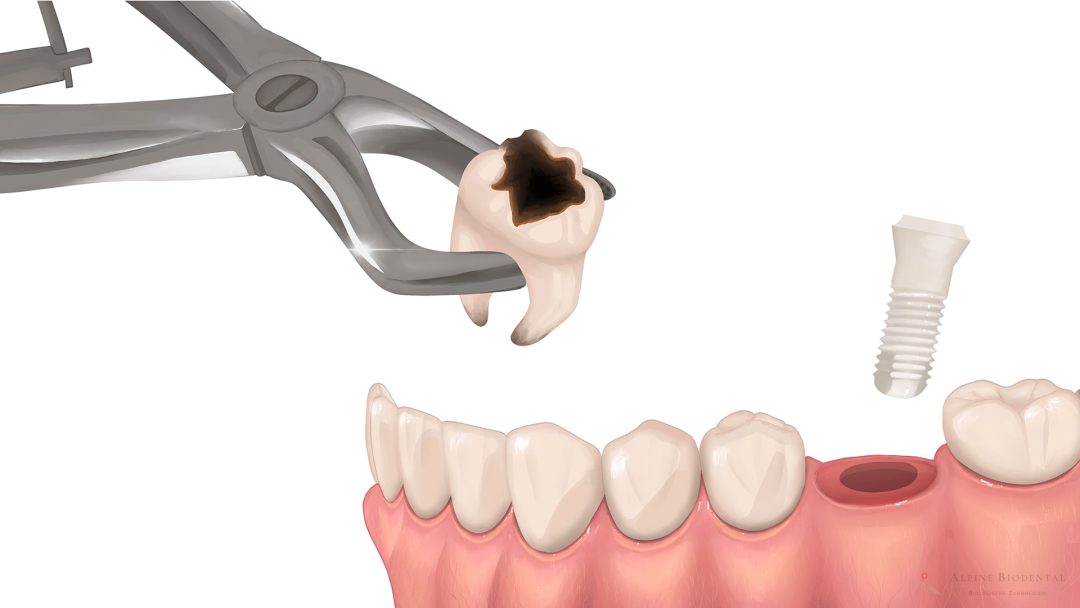Immediate Ceramic Implant

Immediate implant refers to an implantological procedure in which a tooth is extracted and replaced by a dental implant in the same session. Such implantation technique offers significant advantages over delayed implantation and should always be preferred if the conditions are met.
In delayed implantation, on the other hand, the affected tooth is removed in the first dental session, and the implant is placed in the healed area only after several months. Consequently, there is a two-step process, also referred to as a two-stage approach.
Advantages of Immediate Implants
- Eliminates the need for a second surgical procedure, reducing overall patient burden. Patients find immediate implants much more comfortable than tooth extraction followed by delayed implantation months later.
- When a tooth is extracted, the jawbone and mucous membrane gradually recede, leading to resorption. Inserting an implant stabilizes the tissue, preventing bone loss.
- After tooth extraction, the bone wound is optimally prepared for bone healing. This is a natural biological response to tooth loss. Placing the implant at this precise moment ensures ideal bone healing and implant integration.
- Following tooth loss, bone healing should match the size of the lost tooth. Immediate implantation fills a significant portion of the bone void immediately, leaving smaller gaps between bone and implant. As a result, the jawbone requires significantly less effort to rebuild the defect with fresh bone.
- The patient does not leave with a tooth gap or denture but receives a fixed provisional restoration after implantation, particularly important in the visible, aesthetic area.
- Since a second procedure is unnecessary, the treatment is completed much faster. The patient receives a fixed dental prosthesis without delays.
Gentle and Atraumatic Tooth Extraction
For an immediate implant, it is crucial to preserve the bone as much as possible. This requires complete tooth extraction without unnecessarily removing or traumatizing the bone, demanding a high level of experience and skill from the surgeon. Unnecessary compressions and contusions of the bone and gums should be avoided.
This ensures that an implant of sufficient length and width can be selected. Additionally, the atraumatic surgical technique helps prevent unpleasant swelling and pain after the operation.
Prerequisites for Immediate Implantation
- Immediate implantation demands greater surgical skill and experience.
- Careful removal of the tooth without unnecessary trauma.
- Complete cleaning of inflammations and foreign bodies under the tooth and thorough disinfection of the wound.
- After tooth extraction, the existing bone must be optimally utilized for implantation.
- The remaining bone should ensure adequate primary stability of the implant. If there is insufficient bone (in height and width), a two-stage approach should be preferred.
Disadvantages of Immediate Implantation
- If the extracted tooth is larger than the implanted implant, a gap between the mucous membrane and the implant body remains immediately after implantation. This gap is closed as the gum grows and attaches to the implant, a process taking one to two weeks. In delayed implantation, no gap exists between the mucous membrane and the tooth. To address this disadvantage, A-PRF membranes are used in late implantation, filling the void completely and protecting the wound.
- In general, both immediate and delayed implants should not be loaded in the first few months. This point is slightly more critical for immediate implants and should be considered by the treating dentist.
Immediate Implantation with Ceramic Implants
Zirconia ceramic implants are ideal for immediate implants, as both bone and mucous membrane quickly and favorably bond with this biological material.
To best meet the requirements and disadvantages of immediate implantation, we use ceramic implants from various manufacturers. This allows us to provide our patients with the optimal results.
Dr. med. dent. Josephine Phillips
A ceramic immediate implant can prevent bone loss and avoid frequent sessions.

Frequently asked Questions on Immediate Implants
With the use of immediate implants, the jawbone can be preserved, and the patient can receive their desired tooth replacement much faster. As specialists in immediate implants, we are here to assist you with any questions you may have.
Immediate implants should not be performed when there is insufficient bone after tooth extraction to stabilize a ceramic implant. This is the case when there is approximately two to three millimeters of vertical remaining bone. Particularly in cases of larger infections at the root tip, there is a reduced bone height.
A careful consideration should also be given in cases of general conditions such as osteoporosis or tumor diseases.
As long as the dentist possesses the necessary experience and all considerations are taken into account, the prognosis for successful integration is comparable to that of delayed implantation.
Yes, this is particularly recommended in the front tooth area. To prevent excessive strain on the implants, the temporary restorations are also connected to adjacent teeth. After approximately 3 months, the temporary restorations are replaced with finished ceramic crowns.
Before immediate implantation, periodontitis is treated, and the oral bacterial flora is improved. Therefore, after the healing of gum inflammation (gingivitis), we can proceed with placing immediate ceramic implants.
Further information
Here are additional details on the topic to provide you with a deeper understanding.